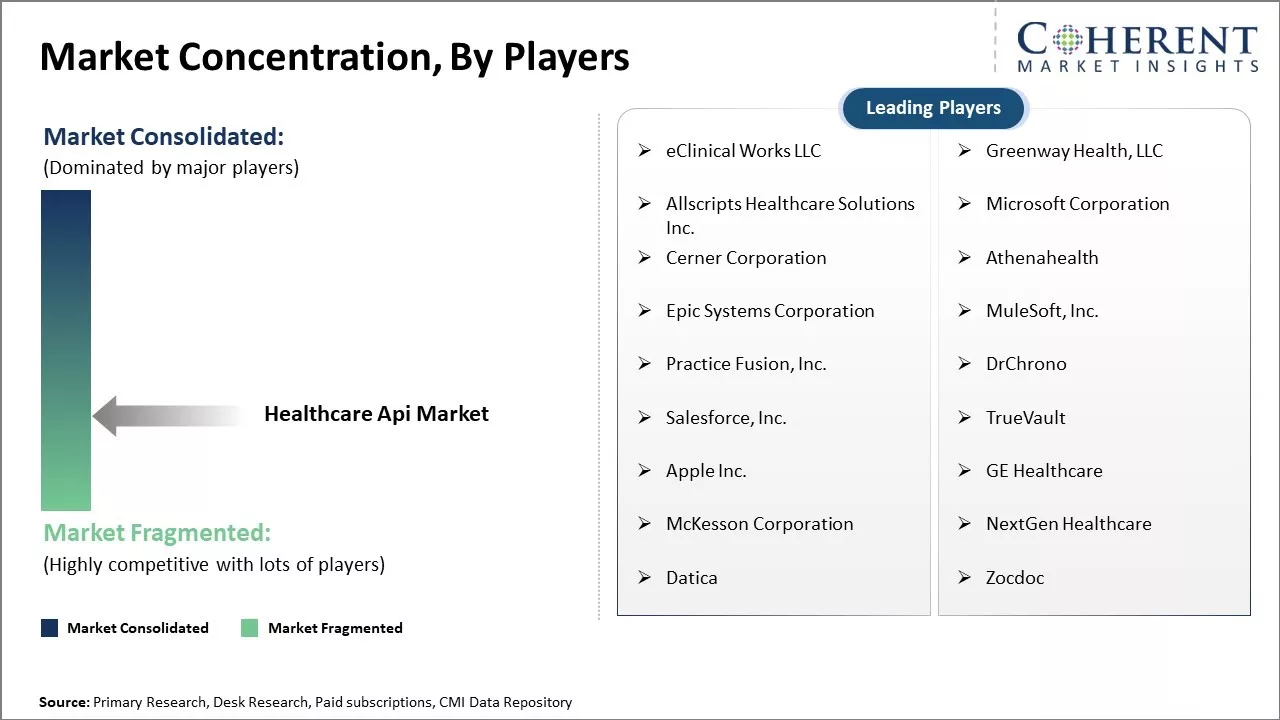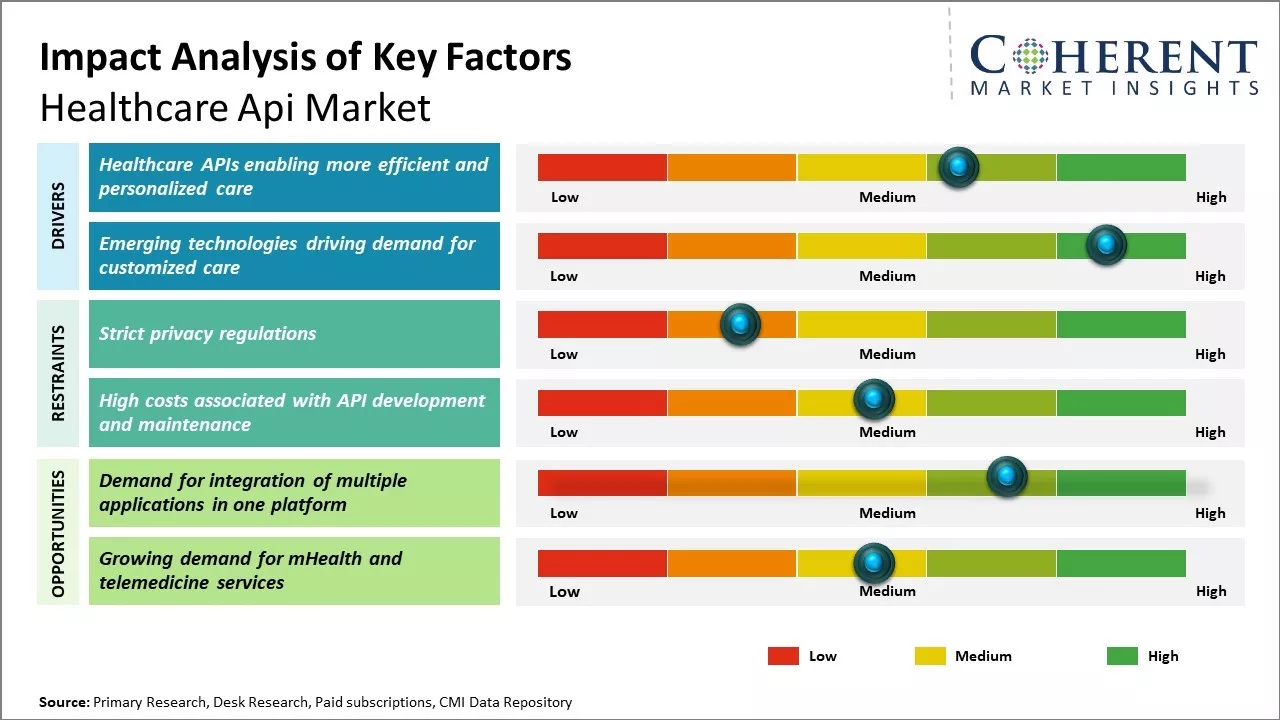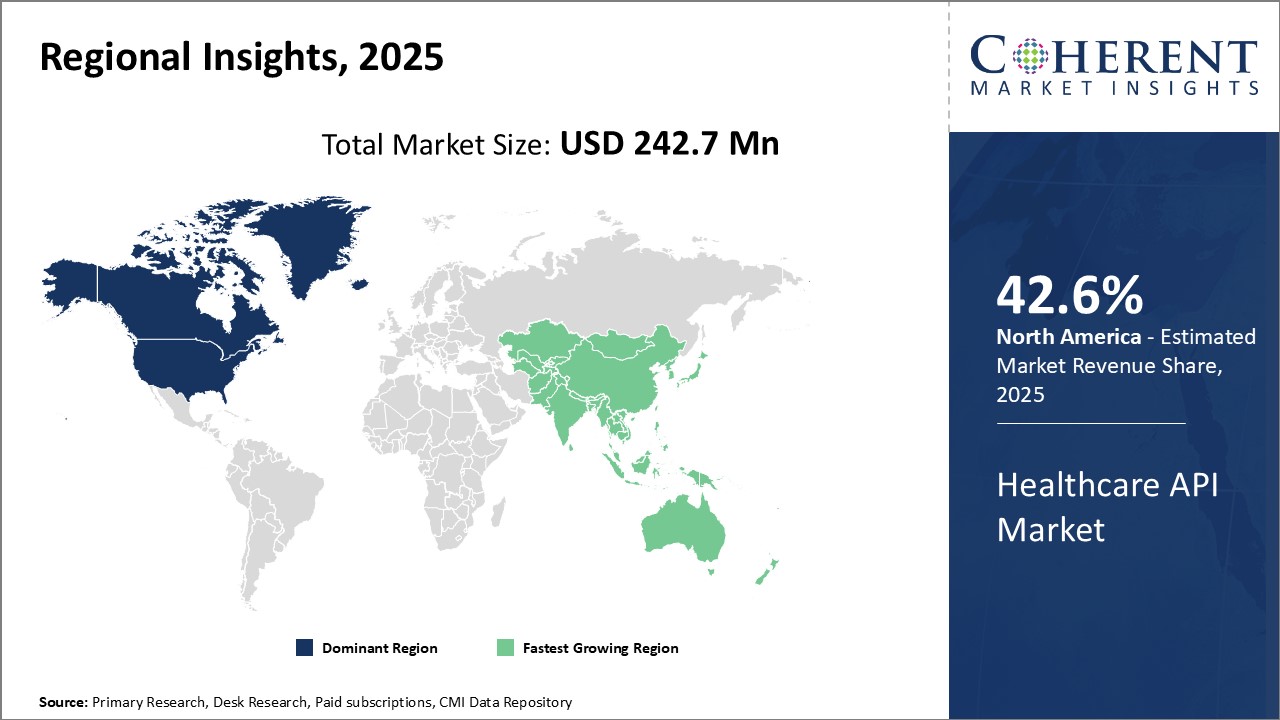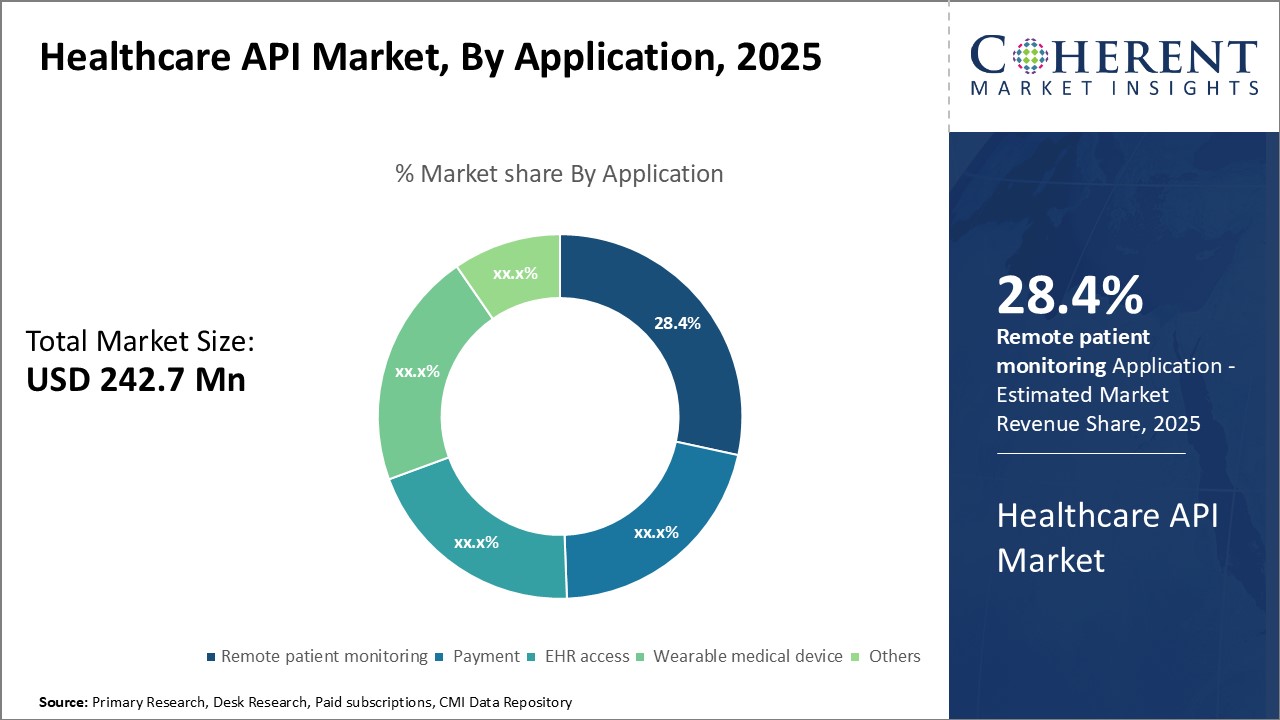Healthcare API Market Size and Trends
The healthcare API market is estimated to be valued at USD 242.7 Mn in 2025 and is expected to reach USD 372.5 Mn by 2032, exhibiting a compound annual growth rate (CAGR) of 6.3% from 2025 to 2032.
Key Takeaways of the Global Healthcare API Market
- By application, the EHR access segment is projected to dominate the healthcare API market, contributing 77. 4% market share in 2025.
- By deployment, the cloud-based segment is expected to lead the market, accounting for 77. 4% share in 2025.
- By end user, the healthcare providers segment is anticipated to hold the largest share, comprising 44. 4% of the market in 2025.
- By region, North America remains the dominant player in the healthcare API market and is estimated to account for 42. 6% of global market share in 2025.
Market Overview
The global healthcare API market is poised for strong growth through 2032, driven by the rapid digitization of healthcare systems, increasing adoption of wearable medical devices, and the rising need for seamless data interoperability. Healthcare APIs play a crucial role in enabling real-time access to electronic health records (EHR), supporting remote patient monitoring, and facilitating secure information exchange between stakeholders.
The EHR access segment is gaining significant traction as healthcare providers prioritize data accessibility to enhance patient outcomes and streamline clinical workflows. Cloud-based deployment continues to dominate the market due to its scalability, cost-effectiveness, and ease of integration with existing health IT systems.
Healthcare providers remain the leading end users, leveraging APIs to improve operational efficiency, patient engagement, and care coordination. North America leads the global healthcare API market, backed by advanced healthcare infrastructure, supportive regulations, and widespread adoption of digital health technologies. While the market continues to expand, challenges such as data privacy concerns, integration complexities, and regulatory compliance persist. However, ongoing advancements in API security, interoperability standards, and AI-driven health applications are expected to reshape the healthcare ecosystem in the years ahead.
AI Impacts on the Healthcare API Market
The healthcare API market is undergoing a transformative shift with the integration of artificial intelligence (AI), enabling enhanced interoperability, predictive analytics, and personalized patient care. AI-powered APIs facilitate real-time data exchange, automate clinical workflows, and support advanced diagnostics by connecting diverse healthcare systems. This integration is driving improved decision-making, operational efficiency, and patient outcomes across the healthcare ecosystem.
- In January 2025, Innovaccer Inc., a leading healthcare AI company, announced a US$ 275 Mn Series F funding round. The round was a combination of primary and secondary, and included participation from B Capital Group, Banner Health, Danaher Ventures LLC, Generation Investment Management, Kaiser Permanente, and M12.
- In March 2024, Google introduced Vertex AI Search for Healthcare, seamlessly integrating NLP-powered search and question-answering with FHIR API and MedLM models. This innovation helps clinicians rapidly locate critical EHR data and generate condition summaries.
- At HIMSS25, Meditech unveiled AI-embedded Expanse Navigator and ambient listening tools in February 2025 that automatically generate and summarize SOAP notes during clinical encounters, all via FHIR API for streamlined documentation and interoperability.
Market Concentration and Competitive Landscape

To learn more about this report, Download Free Sample
- Leading players such as eClinicalWorks LLC, Cerner Corporation, Epic Systems Corporation, Salesforce Inc., Apple Inc., and Microsoft Corporation have solidified their dominance in the global healthcare API market. These companies leverage robust EHR ecosystems, cloud computing platforms, and API-driven interoperability solutions to maintain a competitive edge, offering seamless integration across healthcare systems, wearable devices, and patient portals.
- The market, while leaning toward consolidation at the top, also features a diverse mix of regional and niche participants, including Practice Fusion Inc., Greenway Health LLC, DrChrono, TrueVault, and Datica. This results in a moderately consolidated structure where tech giants and EHR leaders coexist with specialized API vendors and digital health innovators. Competitive dynamics are influenced by regulatory compliance (e.g., HL7 FHIR), AI-driven health insights, cloud-native deployments, and strategic partnerships with healthcare providers and payers.
Current Events and Their Impact on the Healthcare API Market
|
Current Events |
Description and its impact |
|
Accelerated Adoption of FHIR Standards Globally |
|
|
E-commerce Boom and Express Freight Growth |
|
Uncover macros and micros vetted on 75+ parameters: Get instant access to report

To learn more about this report, Download Free Sample
Market Trend: Healthcare APIs Enabling More Efficient and Personalized Care
The healthcare API market is experiencing strong momentum as healthcare systems worldwide intensify efforts to digitize operations and improve care delivery. One of the most transformative trends is the use of APIs to dismantle data silos and enable seamless integration across fragmented legacy systems.
APIs are increasingly serving as the interoperability backbone of healthcare IT infrastructure. By acting as a middle layer between electronic health records (EHRs), lab systems, imaging platforms, and administrative applications, APIs are enabling clinicians to access real-time patient information—such as lab results, diagnostic imaging, and clinical notes—from a unified interface. This improved data visibility is significantly enhancing the accuracy and speed of diagnostic and treatment decisions.
In addition to clinical workflows, APIs are also automating administrative tasks such as insurance eligibility checks, prior authorizations, and claims submissions. This is alleviating the documentation burden on healthcare staff and allowing them to focus more on direct patient care.
The growing emphasis on value-based care and patient-centric models is further driving demand for API solutions that support personalized care delivery and real-time data sharing. As providers, payers, and health-tech innovators continue to prioritize interoperability and automation, the adoption of healthcare APIs is expected to accelerate significantly in the coming years.
Market Opportunity: Rising Demand for Integrated Healthcare API Platforms
The healthcare industry has witnessed a growing need for platforms capable of integrating multiple digital health applications and disparate systems. This has led to increased demand for advanced APIs that support interoperability across electronic health records (EHRs), remote monitoring tools, and telemedicine services. As healthcare providers and technology vendors seek unified solutions, opportunities are emerging for companies to develop experience layers and API marketplaces that streamline data exchange. Moreover, there is a strong need for APIs that can securely analyze or transport large healthcare datasets while ensuring patient privacy. Addressing these integration and data-sharing challenges could reduce operational costs, enhance care coordination, and empower patients with greater access to their medical information.
In December 2024, CMS finalized CMS‑0057, requiring healthcare providers and payers to implement five FHIR-based APIs to support interoperability, prior-authorizations, and enhanced patient access to data. This rule enables digital health platforms to build on top of provider APIs for streamlined workflows and patient empowerment.
Healthcare API Market Insights by Application: Remote Patient Monitoring Gains Momentum in Connected Care Ecosystems
The remote patient monitoring segment is projected to account for 28.4% of the healthcare API market share in 2025, fueled by the surge in chronic disease prevalence and the shift toward value-based care models.
APIs play a pivotal role in enabling real-time data exchange between wearable devices, mobile health apps, and provider platforms—allowing clinicians to continuously monitor patients outside of clinical settings. This capability supports early intervention, reduces hospital readmissions, and enhances patient engagement.
As healthcare systems increasingly adopt virtual care solutions, APIs that support seamless integration of sensor data, vitals, and patient-reported outcomes into clinical workflows are becoming indispensable. With rising investments in remote monitoring infrastructure and interoperability frameworks, this segment is set to become a cornerstone of modern, patient-centered healthcare delivery.
Healthcare API Market Insights by Deployment: Cloud-Based Segment Dominates with Scalable and Cost-Efficient Solutions
The deployment segment includes cloud-based and on-premise solutions. The cloud-based segment is projected to hold 77.4% of the healthcare API market share in 2025, driven by its scalability, flexibility, and lower costs.
Cloud platforms eliminate the need for significant upfront investments in infrastructure and offer a pay-as-you-go model, allowing healthcare providers to scale services based on demand. This reduces over-provisioning and improves resource efficiency.
Cloud deployment also eases the IT management burden, as service providers handle maintenance, updates, and security. With built-in redundancy and disaster recovery features, cloud-based APIs ensure higher availability and reliability, making them the preferred choice for modern healthcare systems.
Healthcare API Market Insights by End User: Healthcare Providers Segment Leads Amid Shift to Value-Based Care
The end user segment includes healthcare providers, payers, patients, and vendors. The healthcare providers segment is projected to hold 44.4% of the market share in 2025, driven by the growing adoption of value-based care models.
As the industry shifts from fee-for-service to outcome-based reimbursement, providers are under pressure to manage populations, coordinate care, and track quality metrics. Healthcare APIs enable these capabilities by supporting data integration and analytics that deliver actionable insights. This allows providers to identify at-risk patients, close care gaps, and improve outcomes—driving continued API adoption within the healthcare providers segment.
Regional Insights

To learn more about this report, Download Free Sample
North America Healthcare API Market Analysis and Trends
North America is projected to hold a dominant 42.6% share of the global healthcare API market in 2025. This leadership is driven by advanced healthcare infrastructure, strong digital health adoption, and the presence of major health IT companies headquartered in the U.S. and Canada.
The region’s focus on healthcare digitization and system interoperability has significantly accelerated the demand for APIs that enable seamless data exchange across electronic health records (EHRs), insurance platforms, and pharmacy systems. Leading hospitals, insurers, and healthcare providers increasingly rely on APIs to support clinical workflows, process claims, and improve patient engagement.
For instance, in March 2021, Redox, a major API integration platform, collaborated with Curative during the COVID-19 response to handle unique testing-reporting requirements in each U.S. state. Redox’s API connectivity streamed data directly from testing providers into public health systems, scaling integration across thousands of systems reliably. Powered by AWS, Redox’s platform grew more than 500% in connections over one year.
In addition, policy shifts toward value-based care and population health management have further highlighted the need for integrated, API-powered platforms. With ongoing investments in digital transformation and health tech innovation, North America continues to lead the global healthcare API market.
Asia Pacific Healthcare API Market Analysis and Trends
Asia Pacific is emerging as the fastest-growing regional market for healthcare APIs, fueled by rapid healthcare modernization, rising digital health investments, and expanding patient populations across countries such as China, India, and Japan.
Government-led initiatives aimed at strengthening healthcare access and infrastructure are accelerating the adoption of API-driven digital solutions, including EHR integration, telehealth platforms, remote patient monitoring, and online pharmacy services. These advancements are creating a favorable environment for healthcare API deployment across both urban and rural settings.
The region’s large and diverse patient base presents significant opportunities for scalable, tech-enabled care delivery models. To capitalize on this, several global healthcare IT companies have established R&D hubs in Asia Pacific to leverage the local talent pool and tailor innovations to regional needs.
Additionally, the presence of agile local API providers is enabling more cost-effective and localized digital health applications. As digital transformation gains momentum, Asia Pacific is poised to become a key growth engine in the global healthcare API market through 2025 and beyond.
U.S. Healthcare API Market Analysis and Trends
The U.S. healthcare API market stands as a cornerstone of global digital health transformation, underpinned by a highly developed healthcare ecosystem, strong regulatory support, and widespread adoption of health IT solutions. The presence of leading EHR vendors, digital health startups, and technology giants has accelerated innovation and integration across the care continuum.
Market growth is driven by the increasing need for interoperability, value-based care initiatives, and patient-centric digital experiences. APIs are playing a pivotal role in enabling secure data exchange between EHR systems, payer platforms, mobile health apps, and telemedicine services. Federal regulations such as the 21st Century Cures Act and CMS Interoperability and Patient Access Rule have further mandated the use of standardized APIs, pushing the industry toward greater transparency and data fluidity.
With a high concentration of healthcare providers, insurers, and health-tech companies, the U.S. continues to lead in developing and implementing API-driven platforms for population health management, real-time analytics, and remote patient engagement. The growing emphasis on consumer empowerment, privacy, and open data exchange is expected to further accelerate API adoption, keeping the U.S. at the forefront of the global healthcare API market.
Pricing Analysis of the Healthcare API Market
1. Service Cost by API Type
• EHR Access APIs
APIs enabling integration with Electronic Health Records (EHRs) are among the most widely used and moderately priced services due to regulatory mandates and high demand.
- Typical pricing ranges from US$ 0.02 to 0.10 per API call, depending on the complexity of the query, volume of data retrieved, and vendor pricing model.
- Example: A mid-sized clinic making 50,000 API calls monthly for patient data exchange may pay around US$ 2,500 per month at an average rate of US$ 0.05 per call.
- Patient Scheduling and Appointment APIs
These APIs support booking systems and patient engagement solutions.
- Cost typically ranges between US$ 0.01 to 0.05 per API call or a flat monthly fee ranging from US$ 100 to 1,000, depending on usage limits and support features.
- Example: A provider using appointment APIs with 10,000 monthly calls at US$ 0.02/call would incur US$ 200 per month.
- Claims and Billing APIs
APIs used for payer integration, insurance verification, and claims submissions carry higher pricing due to compliance requirements and complexity.
- Prices range from US$ 0.05 to 0.20 per API call, with some vendors offering tiered monthly packages starting at US$ 500 per month.
- Example: A billing platform processing 20,000 insurance-related API calls monthly at US$ 0.10/call would pay US$ 2,000.
2. Operational and Maintenance Costs
• Integration and Onboarding Fees
API vendors often charge one-time setup or onboarding fees ranging from US$ 1,000 to 10,000, depending on integration complexity and enterprise size.
- Example: A hospital network integrating multiple systems may incur an onboarding fee of US$ 7,500, covering API configuration, sandbox testing, and training.
- Data Security and Compliance Costs
Vendors that support HIPAA, GDPR, or other data compliance standards often include these features in premium packages, adding 10–30% to overall API service costs.
- Example: A HIPAA-compliant API subscription may cost US$ 3,000/month versus US$ 2,200/month for a non-compliant equivalent.
3. Value-Added Services and Markups
• Analytics and Dashboards
Some API platforms bundle analytics tools to visualize patient data or API usage.
- These tools can add US$ 500 to 2,000/month to subscription plans, especially in enterprise solutions.
- Example: A provider purchasing analytics alongside EHR APIs may pay a bundled fee of US$ 4,000/month.
- Premium Support and SLA Guarantees
Vendors offer service-level agreements (SLAs) with 99.9% uptime, technical support, and incident response under premium plans.
- Pricing for such plans may include a 15–25% markup on base API subscription costs.
- Example: A US$ 5,000 base plan may increase to US$ 6,250/month with added enterprise-grade support and SLA guarantees.
Market Report Scope
Healthcare API Market Report Coverage
| Report Coverage | Details | ||
|---|---|---|---|
| Base Year: | 2024 | Market Size in 2025: | USD 242.7 Mn |
| Historical Data for: | 2020 To 2024 | Forecast Period: | 2025 To 2032 |
| Forecast Period 2025 to 2032 CAGR: | 6.3% | 2032 Value Projection: | USD 372.5 Mn |
| Geographies covered: |
|
||
| Segments covered: |
|
||
| Companies covered: |
eClinical Works LLC, Greenway Health, LLC, Allscripts Healthcare Solutions Inc., Microsoft Corporation, Cerner Corporation, Athenahealth, Epic Systems Corporation, MuleSoft, Inc., Practice Fusion, Inc., DrChrono, Salesforce, Inc., TrueVault, Apple Inc., GE Healthcare, McKesson Corporation, NextGen Healthcare, Datica, and Zocdoc |
||
| Growth Drivers: |
|
||
| Restraints & Challenges: |
|
||
Uncover macros and micros vetted on 75+ parameters: Get instant access to report
Key Developments
- In June 2024, Oracle introduced Oracle Health Insurance Data Exchange Cloud Service, a new solution designed to help healthcare insurers more easily onboard evolving data formats and simplify their complex data exchange needs. With the ability to create custom data mapping and validation rules, insurers can speed the processing of new and proprietary data formats, streamline integration with partners such as the Centers for Medicare and Medicaid Services (CMS), and reduce costly and time-consuming IT projects with a modern, secure data exchange solution.
- In March 2024, NVIDIA launched more than two dozen new microservices that allow healthcare enterprises worldwide to take advantage of the latest advances in generative AI from anywhere and on any cloud. The new suite of NVIDIA healthcare microservices includes optimized NVIDIA NIM AI models and workflows with industry-standard APIs, or application programming interfaces, to serve as building blocks for creating and deploying cloud-native applications. They offer advanced imaging, natural language and speech recognition, and digital biology generation, prediction, and simulation.
- In April 2023, Verato, a leading provider of identity data management solutions for healthcare, announced a strategic partnership with Redox, a prominent healthcare interoperability platform. This collaboration aims to integrate Verato’s identity resolution capabilities with Redox’s composable technology ecosystem. The joint solution enables healthcare organizations to achieve enhanced interoperability, improved data access, and a unified, trusted 360-degree view of patients, providers, and communities. By combining Verato’s identity expertise with Redox’s customizable integration tools, the partnership supports more accurate information exchange and continuity of care across the digital health landscape.
Analyst View: Healthcare API Market (2025–2032)
- The healthcare API market is entering a pivotal phase, driven by the urgent need for interoperability, real-time data exchange, and scalable digital health ecosystems. As healthcare delivery models evolve toward virtual care, consumer empowerment, and value-based reimbursement, APIs are emerging as critical infrastructure that connects disparate data silos and enables intelligent, personalized care experiences. Their role has expanded from being technical enablers to strategic tools that power seamless coordination across EHRs, payer platforms, diagnostics, wearables, and AI-driven decision systems.
- APIs that support electronic health records (EHR) integration have laid the groundwork, but the next wave of growth is being shaped by horizontal expansion into areas such as remote monitoring, clinical triage, patient engagement, and claims automation. Cloud-native API deployments have become the industry default, providing the scalability, security, and compute capacity required to integrate AI models and meet surging data demands. In this environment, digital-first platforms are outpacing traditional IT vendors through modular, plug-and-play offerings tailored to specific use cases.
- Regionally, North America continues to lead due to regulatory mandates like FHIR and the 21st Century Cures Act, while the Asia Pacific region is emerging as the growth epicenter, fueled by mobile-first innovation, expanding public health infrastructure, and supportive digital health policies. This eastward momentum is further accelerated by government-backed initiatives aimed at unifying fragmented health systems through interoperable APIs and cloud solutions.
- On the innovation front, leading vendors are embedding artificial intelligence into APIs, enabling features like risk stratification, real-time clinical alerts, and automated documentation. Generative AI is now being used to enhance patient interfaces and reduce administrative burdens through voice-enabled APIs and smart chatbots. Meanwhile, platformization is reshaping the market landscape—API marketplaces and developer portals are evolving to mirror app store-like ecosystems, making it easier for third-party developers and healthcare organizations to co-create and commercialize interoperable solutions.
Market Segmentation
- Application Insights (Revenue, USD Mn, 2020 - 2032)
- Remote patient monitoring
- Payment
- EHR access
- Wearable medical device
- Others
- Deployment Insights (Revenue, USD Mn, 2020 - 2032)
- Cloud Based
- On Premise
- End User Insights (Revenue, USD Mn, 2020 - 2032)
- Healthcare Providers
- Healthcare Payers
- Patients
- Vendors
- Regional Insights (Revenue, USD Mn, 2020 - 2032)
- North America
- U.S.
- Canada
- Latin America
- Brazil
- Argentina
- Mexico
- Rest of Latin America
- Europe
- Germany
- U.K.
- Spain
- France
- Italy
- Russia
- Rest of Europe
- Asia Pacific
- China
- India
- Japan
- Australia
- South Korea
- ASEAN
- Rest of Asia Pacific
- Middle East
- GCC Countries
- Israel
- Rest of Middle East
- Africa
- South Africa
- North Africa
- Central Africa
- Key Players Insights
- eClinical Works LLC
- Greenway Health, LLC
- Allscripts Healthcare Solutions Inc.
- Microsoft Corporation
- Cerner Corporation
- Athenahealth
- Epic Systems Corporation
- MuleSoft, Inc.
- Practice Fusion, Inc.
- DrChrono
- Salesforce, Inc.
- TrueVault
- Apple Inc.
- GE Healthcare
- McKesson Corporation
- NextGen Healthcare
- Datica
- Zocdoc
Sources
Stakeholders:
- API Solution Providers
- Electronic Health Record (EHR) Vendors and Health IT Integrators
- Hospitals, Clinics, and Healthcare Provider Networks
- Payers and Health Insurance Companies
- Telehealth, Digital Health, and Remote Monitoring Platform Developers
- Cloud Infrastructure Providers
- AI and Analytics Solution Vendors for Clinical Decision Support
Primary Sources:
- Interviews with CIOs, CMIOs, Health IT Directors, and Interoperability Architects (2022–2025)
- Disclosures from Healthcare API Vendors on Product Launches, Partnerships, and Use Cases
- Provider and Payer Case Studies on API Implementation and Outcomes
Expert Commentary from Health Tech Summits and Interoperability Forums
Secondary Sources:
- Company Websites, Annual Reports, and Developer Documentation Portals
- Industry Research from Health IT Publications (e.g., Healthcare IT News, HIT Consultant, MedTech Dive)
- Regulatory Briefs and Guidance from CMS, ONC, FDA, and HL7 Consortium
- Reports from Global Events and Conferences
Proprietary Elements:
- CMI Data Analytics Tool
- Proprietary CMI Existing Repository of Information for Last 8 Years
*Definition: The Healthcare API Market provides development and access to application programming interfaces (APIs) that enable integration of various healthcare data and systems. APIs in this market allow developers to build applications that retrieve and utilize patient records, insurance information, provider directories, clinical/medical data, and other healthcare data. Healthcare organizations and technology companies use APIs from this market to develop innovative digital healthcare solutions that improve patient outcomes, streamline clinical workflows, facilitate research, and enhance data-driven decision making.
Share
Share
About Author
Manisha Vibhute is a consultant with over 5 years of experience in market research and consulting. With a strong understanding of market dynamics, Manisha assists clients in developing effective market access strategies. She helps medical device companies navigate pricing, reimbursement, and regulatory pathways to ensure successful product launches.
Missing comfort of reading report in your local language? Find your preferred language :
Transform your Strategy with Exclusive Trending Reports :
Frequently Asked Questions
EXISTING CLIENTELE
Joining thousands of companies around the world committed to making the Excellent Business Solutions.
View All Our Clients


